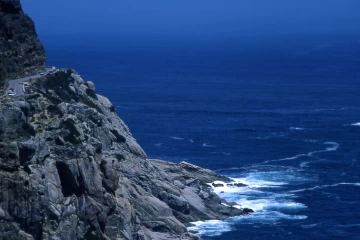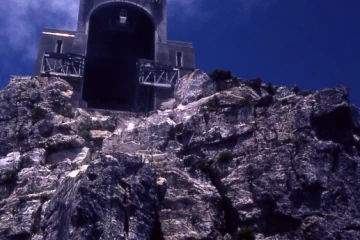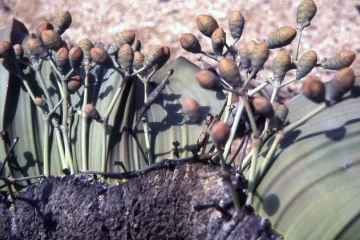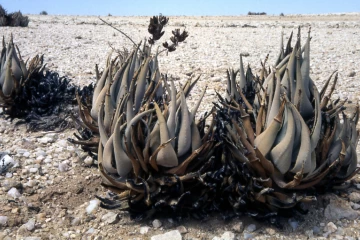Southern Africa: January - July 1999
January - July 1999

A sign of life from Southern Africa
Monday, 8th March 1999 / S-17°15'003" / E-12°26'237"
7.45 am: wake up call; 26°C in the vehicle - the river Kunene flows smoothly - the sun is still hiding behind the mountains - a donkey shrieks - birds are singing. ID & PD, then a pleasant breakfast under the shade of the 200 to 300 year old acacias - a marvellous view, looking north towards Angola, over the bordering river.
9.30 am: after a days rest, we begin today's route. Moving south through the valley "Marienfluss" - driving on narrow sandy tracks, along grassy red dunes (end of the rain season) - we come across familiar herds of springboks. Several ostriches trot away, with their heads raised, herds of zebras cross our path. The impressive experience of encountering elephants, which we had in the Huanib valley, unfortunately does not repeat itself - driving through of several river beds with low water-level.
Only 3 days ago, 100 km further south, we barely escaped being wrecked in the sandy and muddy river bed of the Hoarusib, thanks to the reverse differential gear. To avoid big muddy holes, we had to change our itinerary - TCS and ACS, the Swiss Breakdown services, unfortunately, weren't at our disposal in the Kaokoveld.
Roiidrum
After 60km of rapid drive we reach Roiidrum, a junction of roads marked by a red barrel. We meet a German couple travelling in the reverse direction - exchange of information.
The next 65 km are pretty nerve-racking - only washed-out tracks - on the horizon, in westerly direction, the Skeletton (diamond) park, entry strictly prohibited - thanks to the cool winds from the Atlantic, the temperature today only reaches 34°C.
Orupembe: A stop for food-supply, marked on the map, in reality an abandoned nomadic settlement / kraal and a simple junction.
After 800 km of sand fields and rough tracks we open the reserve tank and drive eastwards to Opuwo.
Hilly landscape - herds of zebras.
5 pm: camp site - at a crest of a pass with a terrific view - after an excellent dinner and enjoying the stars above us, we call it a day and go to bed.
Tuesday, 9th March 1999
Dawn - a herd of goats inspect our camp site - departure - trees on rocky hills - blooming shrubs - canyons - abandoned Himba kraals - wells - a hill and dale track - several river crossins - a thunderstorm building up ahead of us - tropical rainfall - track turns into a slide - water everywhere - what's next? - the track leads through a torrent - do we really have to go cross it?- Edy nods yes! - all of a sudden, just before reaching the other side, a deep hole - the differential gear makes almost everything possible, provided it has been switched on in advance - again, no problem for our truck - at any rate, we've been lucky again.
After 10 days of lonely driving in the Kaokoveld and a distance of 980 km, we reach civilisation again - petrol station: not always fuel, bottle store, food: no fresh produce - refilling water.
Campsite on the bank of the Hoarusib river, under palm trees, 60 km to the west of Opuwo.
Due to the poor light conditions of the day, Edy arranges another photo shooting with curious Himba women for the next day - Using a combination of sign language and Swiss-German - the women misinterpret Edy's symbols for "tomorrow" as "nightly visit".
Distant thunder - sheet lightning in the distance - meal at the campfire.
All of a sudden, literally within seconds, an enormous flood wave washes through the previously dry river bed, measuring 30 metres across, - roaring and thundering - overwhelmed and happy, we observe the scenario - glad to have set up camp, as usual, next to and not in the river bed.
Wednesday, 10th March 1999
7 am: 3 village beauties, 4 boys and the chief of the village, acting as a watchdog and taking all the presents, waiting outside the truck - corn flour, sugar and Edy's military knapsack change hands - photos are taken in a relaxed atmosphere.
We move on to our next destination: Epupa Falls - good gravel track for the first 140 km till Okongwati - the only change in the landscape are the rivers that have to be crossed - 80 km rough, partly steep and rocky track - average speed 10 - 15 km.
We reach our destination and on the river bank, under wonderful palm trees, we set our camp - we enjoy the splendid view of the Epupa Falls - swimming not recommended, far too many hungry crocodiles - nevertheless, the shower at the camp is refreshing despite the brown colour of the water of the Kunene river.
For 4 days, we enjoyed our rest and the special atmosphere with reading and just hanging out.
Our travelling diary describes our trip through the northern part of Namibia, the Kaoko region: approx. 50'000 sq km of untouched landscape. The northern border is formed by the Kunene river, the western border by the Atlantic ocean, the southern border by the Ugab and eastwards, in the direction of Ovamboland, lies the Kaoko limestone plateau. Oranje and Kunene are the only rivers with water all year round, all other rivers are only seasonal (December-April), vegetation is scarce, the country hilly.
Thanks to the seclusion of the region, the Himbas were partly able to protect their culture. The number of livestock (cattle, goats and sheep) indicates the wealth of the approx. 5'000 Himbas. They live within matriarchal structures.
Women and men rub their bodies with a mixture of butter, powder, minerals containing iron, fragrant herbs and myrrh. Mixed together, it forms a red paste, which is used by the women. The men apply black grease instead. The purpose of the rubbing this grease on their bodies is to reduce the loss of body liquid in the heat and to protect them against the cold.
So far, our journey took us from Durban across the "dangerous" Transkai, along the Garden Route and the Indian Ocean to Cape Town. Everything was fine, except that we got stuck for more than 8 days on wonderful wine farms in Paarl and Stellenbosch, the wine-growing areas. Tasting the white wine and making sure to have enough in stock for another 5 months, was essential.
We continued by travelling to the Kalahari Gemsbock Park, Fishriver Canyon, Lüderitz, Sossusvlei, Swakopmund. Terrific landscape, peaceful solitude. Everyday anew we are impressed by Africa's fauna and the friendliness of the people. Our bodies got used to the hot and exhausting climate (below 30°C we are already tempted to wear fleece jumpers). Brigitte solved her problem with the malaria tablets by switching to another type and feels much better now.
The responsibilities (for the daily jobs) are clearly allocated:
Amigo: Security guard on day and night shift, keeping watch over the truck in towns, protecting Brigitte from importunate men, protecting our privacy at the camp site and watching out for animals, while we are driving.
Brigitte: Food and beverage manager, BBQ cook assistant, navigator, co-pilot and responsible for night-time problems.
Edy: Driving carefully, mechanic, campsite manager, fire brigade officer, scout on motorbike and extinguishing the evening fire.
In the guest farm "Sachsenheim", 20 km from the Etosha National Park, we carefully plan our next route for the weeks to come.
We are looking forward to Botswana and Zimbabwe, countries, famous for their breathtaking landscapes, friendly people and all kind of fauna.
Last but not least, we are looking forward to all adventures, which are awaiting us, and of course to seeing you all again after 6 months.
Warmest greetings
Brigitte + Edy
Photos
South Africa: 1999
-
01.1999 S dafrika 001
10 tons on their way to southern Africa
-
01.1999 S dafrika 002
subtropical climate and sunny beaches on the Indian Ocean
-
01.1999 S dafrika 003
South Africa – a melting pot of cultures
-
01.1999 S dafrika 004
No speed limit, but there’s not point in trying to find your contact lenses afterwards.
-
01.1999 S dafrika 005
The Stellenbosch Wine Route leads from one cellar to another.
-
01.1999 S dafrika 006
Ostriches eat considerable quantities of sand and stones – as a digestive.
-
01.1999 S dafrika 007
why don’t you come a bit closer...
-
01.1999 S dafrika 008
well-fed and healthy
-
01.1999 S dafrika 009
Hippos might look clumsy, but are rather fast. They don’t care about who or what is in their way.
-
01.1999 S dafrika 010
camping site on the shore of the Berg River
-
01.1999 S dafrika 011
penguins on Boulders Beach
-
01.1999 S dafrika 012
the gorgeous Jackass Penguin
-
01.1999 S dafrika 013
Hout Bay
-
01.1999 S dafrika 014
Chapman’s Peak Drive – the world’s most spectacular coastal road.
-
01.1999 S dafrika 015
the famous landmark of Capetown, the Table mountain
-
01.1999 S dafrika 016
Rock hyrax live in colonies of over 50 animals.
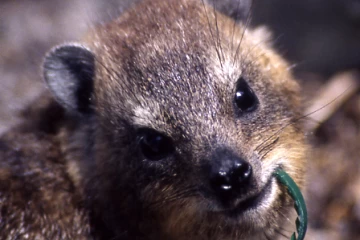
-
01.1999 S dafrika 017
Swartland, the granary of the Cape region
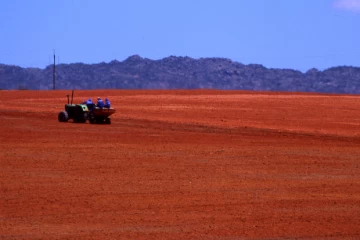
-
01.1999 S dafrika 018
Springboks are known for their vertical leaps.
-
01.1999 S dafrika 019
Due to lack of trees, up to 150 weaver birds have chosen this one to build a nest.
-
01.1999 S dafrika 020
Cheetahs are active during the day.
-
01.1999 S dafrika 021
Arrived!
Photos
Namibia: 1999
-
02.1999 Namibia 001
The Quivertree belongs to the family of succulent trees.

-
02.1999 Namibia 002
Bizarre mountain shapes, awesome and lonely landscapes

-
02.1999 Namibia 003
The expanse, the mountains and the Oranje river make for a fantastic scenery.
-
02.1999 Namibia 004
-
02.1999 Namibia 005
Fish River Canyon – the world’s second largest canyon
-
02.1999 Namibia 006
the world’s oldest desert with the world’s highest sand dunes in Soussusvlei
-
02.1999 Namibia 007
River successfully crossed!
-
02.1999 Namibia 008
Spreetshoogte pass with a gradient of up to 23%
-
02.1999 Namibia 009
Camping site at breezy altitude with a stupendous view.
-
02.1999 Namibia 010
cheese fondue and South African wine
-
02.1999 Namibia 011
corrugation – as far as the eye can see
-
02.1999 Namibia 012
colony of seals near Cape Cross
-
02.1999 Namibia 013
A seal’s fur is soft and smooth to the touch.
-
02.1999 Namibia 014
Namib desert: open and still untouched landscape
-
02.1999 Namibia 015
Welwitschia mirabilis, a primeval plant, up to 1500 years old
-
02.1999 Namibia 016
-
02.1999 Namibia 017
-
02.1999 Namibia 018
Namibia is home to 11 different ethnic groups.
-
02.1999 Namibia 019
Herero woman wearing a typical Wilhelmian traditional costume: its production requires some 12 meters of fabric.
-
02.1999 Namibia 021
Many have tried their luck in the Kolmanskip where diamonds could be found, but only very few became rich.
-
02.1999 Namibia 022
-
02.1999 Namibia 023
“Warmquelle”, a camping site with hot springs
-
02.1999 Namibia 024
Himba kraal
-
02.1999 Namibia 025
Himba women spend several hours every day on their beauty care. They use a mixture of rancid butter fat, herbs and ochre as body lotion.
-
02.1999 Namibia 026
An important part of a woman’s traditional costume is the “ohumba”, a white triton shell.
-
02.1999 Namibia 027
-
02.1999 Namibia 028
-
02.1999 Namibia 029
Road description: in parts very narrow, often with pointed and sharp stones, leading along deep precipices.
-
02.1999 Namibia 030
light and shade
-
02.1999 Namibia 031
Roidrom (an empty, red fuel drum) signals an important junction in Kaokoveld
-
02.1999 Namibia 032
Which is the best place to cross?
-
02.1999 Namibia 033
-
02.1999 Namibia 034
-
02.1999 Namibia 035
just about made it …
-
02.1999 Namibia 036
Shower with water supplied directly from the Epupua waterfalls – even brown water can be refreshing!
-
02.1999 Namibia 037
Himba women wear interesting loincloths.
-
02.1999 Namibia 038
-
02.1999 Namibia 039
-
02.1999 Namibia 040
-
02.1999 Namibia 041
-
02.1999 Namibia 042
extravagant hairstyle
-
02.1999 Namibia 043
-
02.1999 Namibia 020
Colourfully printed fabric is very popular in Africa.














